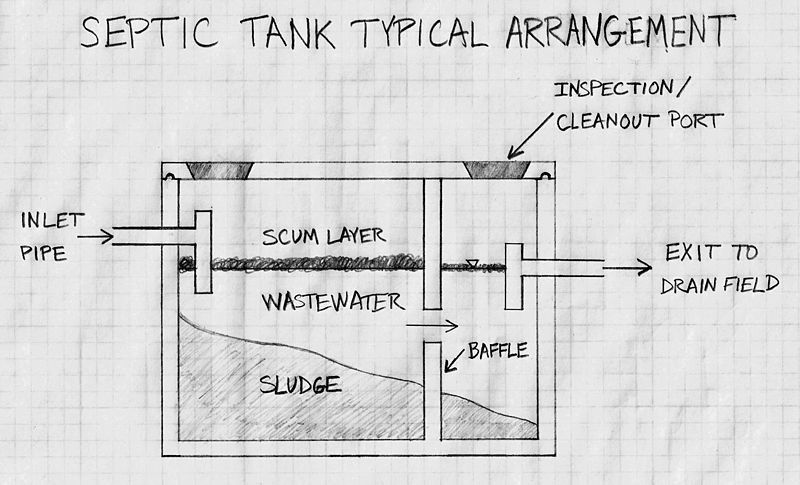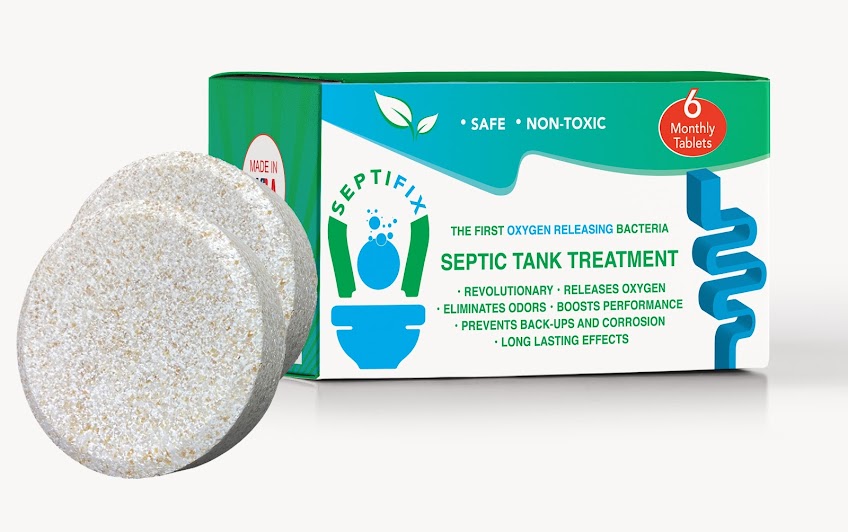How To Fix A Leaking Septic Tank?
During what is ideally a regular septic tank inspection, checking for septic tank leaks should be one of the first things accomplished. Bear in mind that a septic tank can develop cracks over the years, with earth movement, or because the materials used were of substandard quality or it wasn’t installed properly. While older tanks may be more prone to cracking, this vulnerability is likewise true for newer ones because of these very factors. Cracks in the septic tank allow water to seep into the tank and sewage to leak out of it, making it imperative that they be repaired as soon as possible.
Want a Quote to Fix Your Leaking Septic Tank?
Fill our the Septic Service Request Form Below and Local Provider Will Be in Touch Shortly!
First, the tank must be cleaned out and the area in need of repairs has to be scrubbed then dried. Cement filler is added to seal the crack. This task is accomplished with the use of specialized safety equipment. It is not advisable to work on a septic tank yourself due to the toxic fumes and dangerous microbes present even after the tank has been pumped. Before repairs actually begin, your contractor will likely want to determine the cause for cracking. If it’s due to a persisting problem, then cracking is likely to recur. Should this be the case, it might be best to move the tank to a different location or fix the cause, if possible, so no cracks will eventually return over time.
Before repairs are effected, the tank should be inspected for the extent of damage. If the cracks are situated in places that are easy enough to repair, and if it they are minor or superficial, then it might be possible to save the old tank. In case of severe cracks, your septic tank will need to be replaced entirely. If this happens, the old tank is decommissioned first. This involves busting up the concrete and burying it. For a steel or fiberglass tank, they may be crushed first and then buried. The new septic tank is then installed in a whole different location. Below is a more detailed look at how the cracks are repaired.
Filling In the Lid Cracks. Cracks in the lid of a septic tank are most common. Septic tank lids are prone to cracks from pressure (since they are typically buried), such as driving vehicles or operating heavy machinery over the spot. Cracks in septic tank lids are fairly easy to fix, though. Often, this can be solved by adding a concrete filler to the crack and being allowed to cure. Once you notice a crack on your tank’s lid, it is recommended that you hire a contractor to inspect the rest of the tank to ensure there are no cracks elsewhere in the structure. Take note, though, that while it may seem simple to repair a cracked lid, it is still wise to let professionals handle the job. Toxic fumes can seep up through the crack and create hazards, especially to an inexperienced person working around septic tanks.
Repairing Cracks in the Tank. Similarly with septic lids, cracks on the tank structure through where leaks are happening but are not too large or severe may be filled in with concrete filler. But first, the tank needs to be pumped out and cleaned. Allow for some time for the tank to dry out before attempting to fill the cracks. Ideally, a septic professional carries this out. Even with an empty and clean tank, contractors use specialized equipment. Furthermore, entering the enclosed space of a septic tank can be fatal due to the abundance of toxic gas and fumes. After the cracks have been filled and allowed to cure, the rest of the tank should be checked for leaking and other damage. The shifting of the concrete in a concrete septic tank can also cause damage to its baffles, and so these need to be checked as well. Cracks in septic tanks don’t always need to be repaired, though. Tiny, superficial cracks where nothing leaks in or out may be left alone. On the other hand, severe and large cracks might require a total tank replacement.
Since you hardly (if at all) ever see the inside of your septic tank, you won’t be able to detect cracks as they develop. You may never have to deal with a cracked tank, but nonetheless you should be aware of the signs that a crack has developed. Basically, if sewage is leaking out into your yard or if you smell sewer gas anywhere in your property (whether inside or outside your home or facility), you’ll want to call your trusted septic contractor for an immediate inspection. You might just have a clogged system or a full tank. And if your tank has cracked, you’ll want to repair it as soon as possible.
A septic tank is considered “full” when contents have reached the level just below the septic tank outlet opening. Although, pumping the septic tank won’t entirely fix flooded septic tank conditions. But it is important to pump a flooded septic tank for the following reasons:
- If the septic tank was exposed to area flooding it may have become loaded up with mud and silt, then your flooded septic tank needs to be cleaned for it to keep functioning. In this situation, your septic drainfield piping, distribution boxes, and other components need to be excavated sufficiently to in order to be inspected, as well.
- If the septic tank appears to be filling from surface runoff or groundwater leaking into the tank, pumping the tank allows you or your septic service company to diagnose the problems. The diagnosis is better done by observing the empty tank for signs of effluent or groundwater that could be back-flowing into the tank.
- To allow temporary use of a flooded septic tank. If the tank is emptied, and if the home or facility occupants commit to exerting full effort in minimizing unnecessary water usage (in showers, laundry, toilet use, etc.), then the septic system may be used temporarily (a few days to a week) and still be assured of sanitary conditions.
Some experts believe that if a septic tank floods once every 20 years, under exceptional conditions, no design modifications or repairs are necessary besides cleaning the septic tank once the floodwaters subside. But if this happens frequently, the septic system should be deemed unsanitary and may already be a health risk to the facility occupants and its neighbors.
Leaks out of the septic tank can occur if the tank has a hole (for example, a rusted-out metal septic tank) or if a concrete, fiberglass, or plastic tank is cracked or damaged. A leaky septic tank likely means that effluent is not being treated adequately since it is not reaching the drainfield. A septic tank that is not in use AND leaks out may produce solidified scum and sludge that accumulates at or near the base of the tank – rendering it extra difficult to clean. On the other, leaks into the septic tank can happen if groundwater or surface runoff are not diverted away from the septic tank or pipes that carry sewage or effluent in and out of the tank. Any opening that allows surface runoff to enter the septic tank increases the risks of flooding the tank. Especially during rainy weather conditions, the result is a possible water overload in the septic tank, diminishing the level of treatment inside.
DIY-ing Repairs for Septic Tank Problems
Many times, you might find a problem in the pipe system of the tank or in its lid. The good news is both instances are reparable. The biggest problem that frequently occurs with the septic tank pipe is clogging. A septic tank pipe can get clogged by virtually anything from an animal that accidentally finds its way inside or by hardened debris. When your toilets are unable to flush or your sinks are draining slower (if at all) than normal, it is possible that there is a blockage within your septic tank. The first thing to do is to remove the foreign object that is causing the pipe blockage. Learning how to repair the septic tank is a good skill to have, especially in emergency situations.
Step 1: Remove the Blockage. The first step to addressing clogs in your septic tank is to dislodge whatever is causing the blockage. For this, you will likely need a plumber’s snake – a tool which is readily available from most any tool or hardware shop. Run the plumber’s snake down the drain pipe to remove the lodged object causing the blockage.
Step 2: Access the Septic Pipe. If simply running a plumber’s snake down the drain pipe does not address the clog, some digging may be necessary. Use a tool for digging like a hoe to dig through to the lid of the septic tank. Once you’ve gained this access, observe the liquid level inside the tank. If the sewage is at a level which is below the inlet running from the house or facility, it means the blockage is at the other end of the inlet. Use a garden hose and run water through: the water pressure should be enough to help dislodge the object.
Step 3: Inspect the Drain Pipe. It could happen that large debris flowing out of the tank ends up blocking the drain. Also, plants or tree roots are drawn towards the drain pipes, causing blockages. To address this problem, you may use a roto rooter machine to cut through sewer clogs caused by tree roots and other debris. This tool is designed to break down the blocking object/s into tiny pieces and then cleans the entire length of any underground sewer pipe to get it flowing smoothly again. The little, broken down pieces will flow together with the water.
Step 4: Check on the Septic Tank Lid. Septic tank lids are made of concrete and becomes prone to cracking over time because of natural weathering and moisture. Septic tank lids are very expensive to replace. If you find a leak on the lid, immediately repair this with concrete filler. This is the least expensive solution to a manageable leak through the septic tank lid.
Step 5: Clear Out the Lid. Use a screwdriver chip away and remove debris or other materials from the septic tank lid. You may also use a wire brush to scrub the debris out. Do this until the lid is smooth again. For more stubborn debris, you may use water to wash it out.
Step 6: Fill in the Cracks. To repair minor leak-y cracks, you will need a concrete epoxy crack filler kit. Mix the ingredients as directed, then pour into a bucket. Add a little sand and water to reinforce the mixture. Water makes cement easier to pour and helps it to harden. Adding sand makes cement more binding. Cement mixed with water and sand becomes mortar – the paste used to meld bricks together. Apply this filler all over the cracks on the lid, applying just enough pressure as you do so that the filler will go deep into the crack. Smooth the filler out and allow for time to dry.
Causes of Septic Lank Leaks
A septic tank can develop a leak at just about any location, but some of the most common areas are:
- The sewer line entering the septic tank (inlet pipe), or the effluent line leaving the septic tank (outlet pipe). It’s possible that the pipe is not sealed properly in these locations. Many septic tanks, especially the older ones, didn’t come provided with sealant unless some home-made system was effected. Some installers pour concrete around the waste pipe entering the tank. This works, however, renders future repair works to be much more difficult. More modern septic tanks may come fitted with a rubber gasket to help seal the tank entry and exit points. But if the waste lines entering or the effluent lines leaving the septic tank are at a sharp angle vis a vis the tank, the gasket may not seal properly.
- Damaged sewer piping or effluent piping are possible flow points for groundwater or surface runoff to enter the septic tank or flow into the drainfield.
- A below-ground septic tank lid or cleanout port could allow surface water to flow into the septic tank.
- Rust corrosion on a steel septic tank can let effluent leak out of the tank and groundwater to leak in. The latter, especially so, in rainy weather.
- Cracks in a concrete septic tank can likewise allow effluent to leak out or for groundwater to leak in, though this is not as likely as in steel septic tanks.
- Damaged fiberglass or plastic septic tanks can also be infiltrated by groundwater and release effluent at the seams or points of damage. But, again, not as likely as with steel septic tanks.
You can reduce the chances of water leaking into a septic tank by making sure that roof runoff and surface water are diverted and directed away from the septic tank, as well as the drainfield.
Septic Tank Damage to Watch Out For
Septic tank leaks and flooding. One of the most common problems that can be detected on concrete (and sometimes, steel and plastic) septic tanks is tank flooding due to a drainfield back-up or because of surface runoff or groundwater leaking into the septic tank. Water also leaks into septic tanks from inadequately-sealed pipe connections, leaky septic tank risers, and cracked septic tank covers. How can you tell if your septic tank is flooded? If, upon careful inspection, you see an abnormally high sewage level or signs of effluent overflowing the baffles or tees, then it’s time to call for professional help.
Cracks in concrete septic tanks. Concrete
tanks are vulnerable to cracking or some sections separating causing leaks.
This typically happens because of improper disposal of effluent and when the
system is left un-used for long periods, causing the liquid levels on the tank
to drop to abnormally low levels.
Concrete septic tanks are also prone to erosion if poorly-mixed or
low-quality concrete was used in its fabrication. If there is a blockage at the
tank outlet or absorption system, you may observe that, upon examination of the
tank’s interior, effluent is or has been above the level of the baffles. This
is an indication of possible system failure. The septic inspector could easily
detect this problematic condition only if there is a tank inspection port which
is readily and safely accessible when running a loading and dye test.
Damaged or displaced septic tank baffles. Even though concrete is quite durable and long-lasting (given that it’s been properly mixed and set), some mediocre concrete septic tank installations can leave you with cracked, broken, crumbled, or even displaced baffles. Without the necessary inlet and outlet baffles, the septic tank sends solids to the drainfield, compromising your drainfield’s lifespan. A lost baffle at the tank inlet can result to blockage in the sewer line, eventually causing sewage backup in the home or establishment.
Septic tank placement. If the tank has not been properly set on compacted soil, gravel, or another sound surface, it may settle or tip, causing sub-par operation or even leaks, blockages, and broken pipes.
Displaced, missing, or un-secure septic tank access covers. These conditions are hazardous in that these are possible causes for falls into the tank, which is usually fatal. Always take precautions, be sure to keep people away from the area of a septic tank, especially those of unknown condition due to lack of regular maintenance and inspection.
Signs of a Septic Tank and System Failure
We’ve all heard of the age-old proverb that the grass is always greener on the other side. But this is not true for septic systems. If you notice especially (yes, oddly) green, healthy, or lush patch of vegetation relative to the rest of the yard, it could mean that your septic tank has a leak or that your lateral lines are receiving far too much wastewater downstream from the septic tank and thus saturating your yard. You might even observe pooling of raw sewage on your lawn, which, in itself, is a dangerous environmental and health hazard.
Besides what’s described above, other indications of a possible septic tank or septic system failure include:
- Back-ups of water and sewage in your toilets, drains, and sinks.
- Exceptionally slow draining in your bathtubs, showers, and sinks.
- Gurgling sounds within the plumbing system.
- Standing water or damp spots near your septic tank and/or drainfield areas.
- Unpleasant odors around the septic tank and/or drainfield areas.
- Noticeable algae growth in nearby ponds or bodies of water.
- High levels of nitrates or coliform bacteria in water wells in your area.
A Leaking Septic Tank is Dangerous to Health
A failure in any septic system potentially means untreated sewage is released and ends up in places where it shouldn’t be. This means you can end up with sewage puddling on your ground’s surface, especially around the septic tank or the drainfield, or to back up into your home’s or building’s pipes. Raw sewage could also find its way into groundwater, surface water, or nearby marine water without you realizing it. Raw sewage contains pathogens and other contaminants that pose real health hazards, both to humans, flora, and fauna. It can likewise contaminate water sources, rendering it highly unsafe for drinking, swimming, marine ecosystems, and agricultural functions.
It pays to be aware that, around the world, 80% of all infectious diseases are water-borne? Also, diarrheal diseases linked to contaminated water have been fatal to approximately two million children and cause exponentially more instances of illness annually?Septic tank systems are the largest of all wastewater sources that reach the ground and are the most frequently reported contributors of groundwater contamination in the United States. Bacteria, viruses, and parasites are the types of pathogens that wastewater carries. Fungi that cause skin, eye, and respiratory infections thrive in sewage and sludge. These pathogens may be transported rapidly and could contaminate nearby water sources or recreational surface water.
Bacteria are microscopic organisms that have been found to cause several wastewater-related infections, including typhoid, dysentery, gastroenteritis, and cholera. Most of such bacteria infect the stomach and intestinal tracts and can cause symptoms like headaches, diarrhea, fever, nausea, and vomiting. Depending on the bacteria involved, symptoms can begin hours to several days after ingestion of contaminated water.
Viruses can’t multiply outside their hosts, and wastewater is a hostile environment for viruses. Nevertheless, some viruses survive in water enough to cause infections. Hepatitis A, polio, and viral gastroenteritis are but some of the diseases that can be contracted from viruses in sewage. There may be as many as 100 different types of viruses carried by raw sewage, but they are not easy to identify.
Parasites that can be found in wastewater include protozoans and parasitic worms. When ingested, water contaminated with protozoans can cause mild to severe diarrhea. Protozoans can multiply inside the body and cause diseases like amoebic dysentery. Parasitic worms and their eggs can also thrive in raw sewage. Tapeworms and roundworms are the most common types found in the U.S.
Children and the elderly have been the most significantly affected age groups by wastewater-related infections. Infections like these in the mentioned age groups are frequently fatal because most of these diseases cause severe dehydration.
You will be able to tell if sewage from your septic tank is making its way to your surface water if:
- You notice an excessive weed or algae growth in water formations nearby. Nutrients leaking from septic tank systems could be a major cause of this type of lush growth.
- You observe foul odors, soggy soil, or liquid waste puddling on your yard’s surface. These symptoms often indicate failure in your septic system and the immediate need for repairing, or worst, replacing the drainfield.
- Test results conducted by your local health department indicate the presence of biological contamination. Such tests may show the presence of harmful bacteria in the water. Although septic system wastes are not the sole source of these contaminants, they are the most likely suspects.
Indicator dye applied into your septic tank reaches nearby ditches or bayous. Dye tests are available from your local health department and can help to detect the problems with your septic system that are otherwise difficult to notice.
Prevention is always the best strategy for protecting the environment and everyone’s health, as well as preserving valuable water resources used for consumption and recreation. The following recommendations may help avoid wastewater contamination:
- Submit your septic system to regular and periodic inspection and maintenance.
- Make conservative water use a habit among your home’s or property’s occupants.
- Divert and redirect surface water flow away from your septic system.
- Do not drive vehicles or operate heavy machinery over your septic system (tank and drainfield).
- Plant a “greenbelt” (a grassy strip or a patch of short-rooted vegetation) between your septic system and nearby shoreline.
Like most structural elements of your home or business property, septic systems require routine and periodic maintenance. If maintained adequately and in a timely manner, your septic system should provide you reliable service for several years. On the other hand, if your septic system has not been receiving proper inspection and care, you are running the risk of dangerous and costly system failures, not to mention health issues and environmental impact. Bear in mind, too, that septic systems likewise have an operational life cycle and will eventually need to be replaced.
We cannot reiterate this enough: a malfunctioning or failing septic system is a critical risk to human and animal health and can contaminate the environment. Once your septic tank has had cracks, you should have it inspected every year, even if it isn’t yet scheduled for a cleaning or a pumping. Be prompt in contacting your trusted septic system specialist for proper assessment and assistance. A responsible septic system owner should always be alert to the signs of system failure, regardless of how long the system has been operational, and should respond promptly once any issues are detected. A quick response could potentially save you money in repairs or replacement and, more importantly, may prevent illness and negative implications on the environment.
GET LOCAL SEPTIC SERVICE
Visit our State Directory For Local Septic Repair, Pumping, & Installation Service Providers
Resources
https://inspectapedia.com/septic/Septic_Tank_Leak_Causes.php
https://inspectapedia.com/septic/Concrete_Septic_Tanks.php
https://www.doityourself.com/stry/how-to-repair-septic-tank-problems
https://rucysoap.com/2017/11/10/3-tips-to-deal-with-a-leaking-and-failing-concrete-septic-tank/
https://www.doh.wa.gov/CommunityandEnvironment/WastewaterManagement/SepticSystem/SignsofFailure
https://www.hunker.com/13425059/does-gravel-make-the-best-base-for-a-concrete-slab











